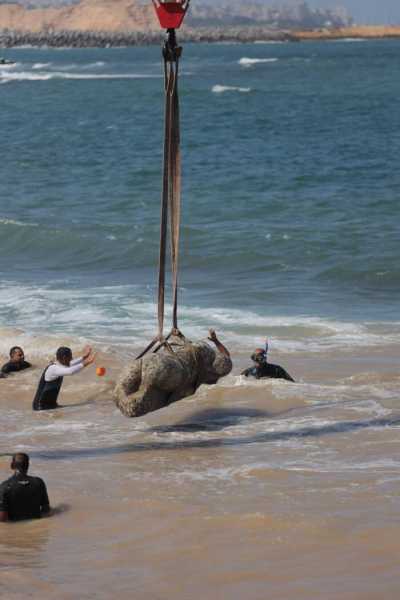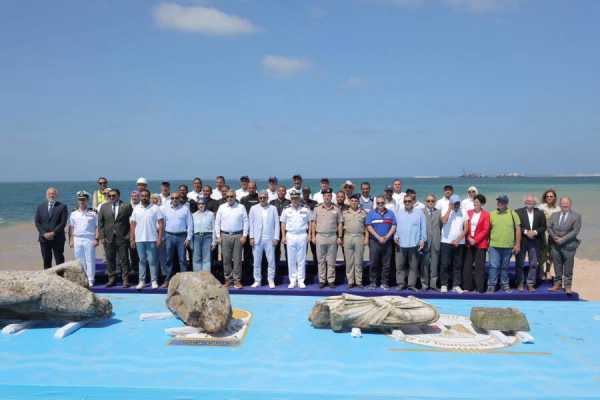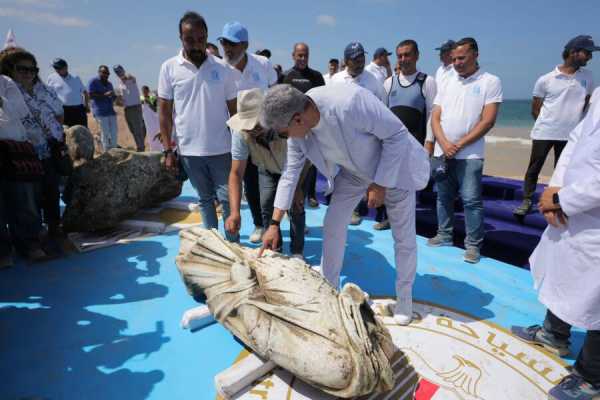
Egyptian Ministry of Tourism and Antiquities Divers raise statues from Abu Qir Bay near Alexandria, Egypt.
Archaeologists and divers exploring the waters off Alexandria in northern Egypt have recovered a trove of artefacts from a sunken city believed to be part of ancient Canopus. The operation uncovered monumental sculptures, architectural fragments and other relics from the Ptolemaic and Roman eras.
The discovery, announced this week by Egypt's Ministry of Tourism and Antiquities , reveals new details about the city that flourished more than two millennia ago before sinking underwater.
Canopus: An underwater discovery
On August 21, 2025, three stone statues were raised from the shallow waters of Abu Qir Bay near Alexandria. Since the 1990s, a team of French archaeologist Franck Goddio has been conducting underwater research here. Canopus, a religious center for the worship of the god Serapis , played a key role during the Ptolemaic era (305–30 BC), attracting pilgrims from all over the Mediterranean with large-scale celebrations.
Among the finds are a quartzite sphinx with carved slabs from the time of Ramses II, a granite colossus of an unknown character and a marble statue of a Roman aristocrat. Bronze objects, ritual artifacts and parts of temple columns were also found, confirming the existence of grandiose sanctuaries.

Egypt's Ministry of Tourism and Antiquities. Archaeologists and officials are pictured with ancient sculptures.
The event also marked the first underwater operation of this scale in the country in 25 years.
Tourism and Antiquities Minister Sherif Fathy described the project as a “milestone” in efforts to preserve Egypt's cultural heritage.
City buried under water after disaster
Canopus and neighboring Thonis-Heracleion disappeared under the sea more than a thousand years ago due to a series of natural disasters. Scientists attribute their sinking to earthquakes, rising sea levels and liquefaction of the soil caused by the shifting Nile Delta.
Over time, the temples and city blocks collapsed, becoming buried under layers of silt until modern technology made it possible to explore them.
Underwater work is not without its challenges. Experts work in murky waters with visibility of less than a meter, using advanced sonar and magnetometers to map the ruins. New findings from the temple complex suggest that Canopus rivaled land-based cities in monumentality.
The artefacts also highlight the city's role as a pilgrimage centre. Sources mention a temple to Serapis, a deity created by the Ptolemies to unite Greek and Egyptian beliefs.

Egyptian Ministry of Tourism and Antiquities Minister Sherif Fathi inspects statues raised from the water.
Pilgrims flocked to the sanctuary for healing, and city festivals included musical performances, ritual processions, and rich offerings.
Scientists assume that the statues were ritually placed in temple precincts. The preservation of the artifacts allows us to study the combination of Hellenistic and Egyptian styles. Inscriptions on some objects may indicate the names of the donors or their role in the rituals.
However, only a fraction of the finds are being raised. “There is a lot of stuff preserved underwater, but we can only raise certain objects that meet strict criteria,” Fathi told The Guardian . “The rest will remain part of the underwater heritage.”
A Window into Egypt's Maritime History

Egypt's Ministry of Tourism and Antiquities. Minister Fathy thanks the participants of the underwater expedition.
The discovery comes as Egypt is trying to promote its heritage. The ministry is promoting underwater archaeology to expand tourism beyond land-based sites. Canopus and Thonis-Heracleion, dubbed the “Egyptian Atlantis,” have captivated the world for decades, with entire urban structures preserved underwater.
Such finds deepen our understanding of the role of coastal cities as centres of cultural interaction. Canopus, which thrived on trade and pilgrimage, served as a link between Egypt and the Mediterranean.
Alexandria Governor Ahmed Khaled Hassan Said called the discovery an archaeological breakthrough and “the return of a lost chapter of our great history.”
Learn more about the Library of Alexandria and the reasons for its disappearance, then explore the history of the legendary Lighthouse of Alexandria.
Sourse: www.allthatsinteresting.com





